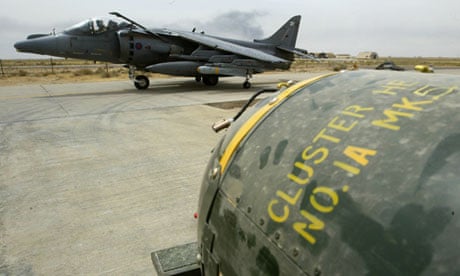Most of Britain's stockpile of cluster bombs – which kill and maim civilians long after they have been dropped – has been destroyed, according to campaigners who monitor the 2008 international convention banning the weapons.
The coalition government has pursued a lead role started by Gordon Brown's Labour administration in getting rid of cluster bombs. British forces used air-launched and ground-launched cluster bombs in the Falklands, Kosovo and the former Yugoslavia, and in the Gulf and Iraq wars.
Though the convention was signed by more than a hundred countries and was applauded by humanitarian groups, it also contains some potentially significant loopholes.
The UK had declared a stockpile of 191,128 cluster bombs and 38,758,898 submunitions – "bomblets" which are scattered around a wide area but frequently do not explode on impact. They can later kill and maim civilians, including children, who disturb the canisters.
The UK stockpile was withdrawn from service by 30 May 2008 and the majority had been destroyed by July this year. British officials reported that more than 70% of the UK stockpile had been destroyed, though more than 11m "bomblets" remained, the international Cluster Munition Coalition (CMC) said on Thursday.
A total of nearly 750,000 cluster bombs containing 85.8m submunitions, representing more than 60% of all declared stockpiles, have been destroyed according to the CMC's Cluster Munition Monitor 2012 report released in London.
More than 48,000 unexploded submunitions were destroyed during clearance operations over an area amounting to 55 sq km (21 sq miles) across 10 countries.
"The impressive number of stockpiled cluster bombs destroyed under the Convention on Cluster Munitions demonstrates just how committed governments are to rapidly implementing this treaty," said Mary Wareham of Human Rights Watch. "It is proving to be a milestone in humanitarian disarmament diplomacy, and the hold-out states that have not yet joined need to get on the right side of history."
Countries that have not signed the 2008 Oslo convention banning cluster bombs include the US, Russia, China and Israel. There have been reports recently of a renewed use of cluster munitions in Syria and Sudan, two countries that have also not signed the Oslo convention. Nevertheless, campaigning groups say their report provides powerful proof that the convention is already saving millions of lives.
The convention's main potential loophole allows armed forces of countries that have ratified the Oslo convention to "facilitate" operations including the use of cluster bombs by countries, such as the US, that have not signed up to the ban.
It also does not stop British companies and institutions from investing in companies that continue to produce cluster bombs.
The US has said it has removed its cluster bomb stockpile from Britain and British overseas territories, including the Indian Ocean island of Diego Garcia.
The report was launched before of the convention's third review conference in Oslo next week.
The Convention on Cluster Munitions entered into force on 1 August 2010, and prohibits the use, production, transfer and stockpiling of cluster bombs. It requires the destruction of stockpiled cluster munitions within eight years, clearance of cluster munition remnants within 10 years, and assistance to victims, including those killed or injured by submunitions as well as their families and affected communities.
